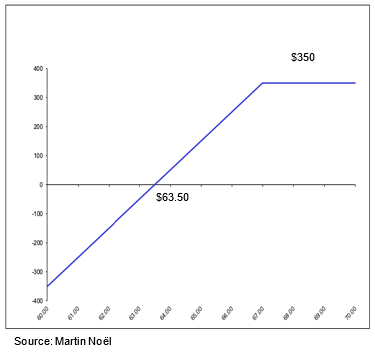Writing covered call options: an introduction

Perhaps you would like to start using options, but you do not know which strategy to implement. The simplest and most popular strategy among individual and institutional investors is covered call writing.
This article is the first in a series of four articles on covered call writing. It covers the basic features of this strategy and why it is used. The second article will discuss how to use the strategy to sell securities held. In the third article, the focus will be on using the strategy to generate income, and the fourth and final article will examine the issues to consider when implementing the strategy.
What is covered call writing?
| Obligations of the call option writer
The writer of a call option has an obligation to sell 100 units of an underlying security (for example, a share) at the strike price if the holder exercises the option before it expires. In exchange for contracting this obligation, the option writer receives a premium paid by the buyer. |
Covered call writing is a strategy that consists of writing one call option contract for every 100 securities (shares of a company or units in an exchange-traded fund) held in a portfolio. The investor receives a premium for writing the call options, and if the price of the underlying security falls, the options protect the investor in an amount equal to the premium received. This premium effectively reduces the cost of acquiring the shares by the same amount. In exchange for these benefits, the investor agrees to sell his or her securities at the exercise price (i.e. the strike price) if the holder of the call options decides to exercise them. As a result, the investor agrees not to benefit from any increase above the strike price until the expiration date of the call options.
Why write covered calls?
There are three main reasons for implementing this strategy. The first is to obtain protection against an expected moderate decline in the price of the underlying asset. The second is to sell the securities held. The third is to generate additional income, either on an ad hoc or systematic basis.
Payoff profile for covered call writing
| In the following example, an investor implements the covered call writing strategy by buying 100 shares of ABC at $65/share and writing 1 ABC call option with a strike price of $67 for $1.50. The total premium received is $150 per option contract ($1.50 per share x 100 shares per option contract). In exchange, the investor agrees to sell the 100 shares at a price of $67/share, if the holder of the call options exercises the contract. | Example of covered call writing |
| Purchase of 100 shares of ABC for $65/share | |
| Sale of one call option on ABC at a $67 strike for $1.50 |
Writing covered calls

Maximum profit Break-even price |
Maximum loss
The maximum loss for the strategy is very high, but the risk to the investor is not more than the risk of simply holding the shares. The maximum amount at risk per share corresponds to the break-even price of $63.50, as calculated above, compared to $65 per share for simply holding the shares. So as you can see, the amount at risk in writing covered call options is slightly lower than the risk incurred when simply holding the shares. The protection obtained corresponds to the premium received, i.e. $1.50 per share.
Protection level
As mentioned above, the premium collected from writing call options reduces the effective acquisition cost of the underlying shares. The value of the premium therefore provides some protection against the share price falling. An investor who expects the price of a security to fall must therefore estimate the size of this potential decline before making a decision on the strategy. If the drop is expected to be large, the investor might be better off simply selling the stock. However, if the investor expects a moderate decline or a stable price over a more or less long period of time, writing covered call options may help reduce the impact of this decline, in whole or in part. It will all depend on the strike price[1] chosen. For more protection, the investor could select a strike price that is lower than the price of the underlying security; this is known as an “in-the-money” call. The more the call option is in-the-money, the higher will be the premium and, consequently, the greater the protection provided by the option.
Conclusion
When executing the covered call writing strategy it is important to understand the market environment. In a very bullish market this strategy tends to generate a smaller profit than simply holding the shares, because the maximum profit is limited to the strike price of the calls written. The strategy’s return therefore depends on our ability to properly assess market conditions. But this is the case for each of our investments. The ideal context for executing this strategy is when we expect the price of the underlying security to remain relatively unchanged or fall slightly over a period of time. The objective of the strategy is to see the call options you have written expire worthless. If this happens and your expectations are unchanged, you can sell more calls, further reducing the cost of your underlying assets. The next article will discuss how to implement this strategy to sell our securities.
Before you start using the strategies mentioned in this article, we suggest that you test them using the Montréal Exchange’s trading simulator.
Good luck with your trading, and have a good week!
The strategies described in this blog are for information and training purposes only. They should not be interpreted as recommendations to buy or sell any security. As always, you should ensure that you are comfortable with the proposed scenarios and ready to assume all the risks before implementing an option strategy.
[1] Nous couvrirons le choix du prix de levée de manière plus approfondie dans le quatrième article.
President
Monetis Financial Corporation
Martin Noël earned an MBA in Financial Services from UQÀM in 2003. That same year, he was awarded the Fellow of the Institute of Canadian Bankers and a Silver Medal for his remarkable efforts in the Professional Banking Program. Martin began his career in the derivatives field in 1983 as an options market maker for options, on the floor at the Montréal Exchange and for various brokerage firms. He later worked as an options specialist and then went on to become an independent trader. In 1996, Mr. Noël joined the Montréal Exchange as the options market manager, a role that saw him contributing to the development of the Canadian options market. In 2001, he helped found the Montréal Exchange’s Derivatives Institute, where he acted as an educational advisor. Since 2005, Martin has been an instructor at UQÀM, teaching a graduate course on derivatives. Since May 2009, he has dedicated himself full-time to his position as the president of CORPORATION FINANCIÈRE MONÉTIS, a professional trading and financial communications firm. Martin regularly assists with issues related to options at the Montréal Exchange.
The information provided on this website, including financial and economic data, quotes and any analysis or interpretation thereof, is provided solely for information purposes and shall not be construed in any jurisdiction as providing any advice or recommendation with respect to the purchase or sale of any derivative instrument, underlying security or any other financial instrument or as providing legal, accounting, tax, financial or investment advice. Bourse de Montréal Inc. recommends that you consult your own advisors in accordance with your needs before making decision to take into account your particular investment objectives, financial situation and individual needs.
All references on this website to specifications, rules and obligations concerning a product are subject to the rules, policies and procedures of Bourse de Montréal Inc. and its clearinghouse, the Canadian Derivatives Clearing Corporation, which prevail over the content of this website. Although care has been taken in the preparation of the documents published on this website, Bourse de Montréal Inc. and/or its affiliates do not guarantee the accuracy or completeness of the information published on this website and reserve the right to amend or review, at any time and without prior notice, the content of these documents. Neither Bourse de Montréal Inc. nor any of its affiliates, directors, officers, employees or agents shall be liable for any damages, losses or costs incurred as a result of any errors or omissions on this website or of the use of or reliance upon any information appearing on this website.
BAX®, CADC®, CGB®, CGF®, CGZ®, LGB®, MX®, OBX®, OGB®, OIS-MX®, ONX®, SCF®, SXA®, SXB®, SXF®, SXH®, SXM®, SXO®, SXY®, and USX® are registered trademarks of the Bourse. OBW™, OBY™, OBZ™, SXK™, SXJ™, SXU™, SXV™, Montréal Exchange and the Montréal Exchange logo are trademarks of the Bourse. All other trademarks used are the property of their respective owners.
© 2024 Bourse de Montréal Inc. All Rights Reserved.
